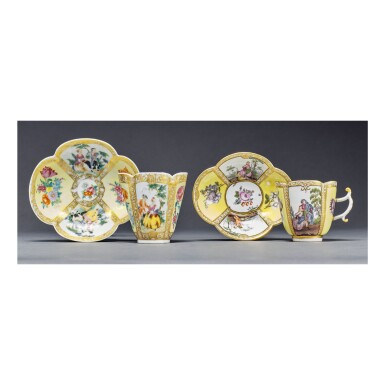Selected Meissen and Other Ceramics from the Collection of Henry H. Arnhold
Selected Meissen and Other Ceramics from the Collection of Henry H. Arnhold

A MEISSEN YELLOW-GROUND QUATREFOIL CUP AND A SAUCER AND A RARE CHINESE EXPORT FAMILLE-ROSE QUATREFOIL BEAKER AND SAUCER CIRCA 1740 AND QING DYNASTY, TONGZHI PERIOD, CIRCA 1865 | 約1740年 邁森開光黃地花卉人物圖海棠式盃連盞 清同治 約1865年 粉彩開光黃地花卉人物圖海棠式盃連盞
Auction Closed
October 24, 05:26 PM GMT
Estimate
2,500 - 3,500 USD
Lot Details
Description
A MEISSEN YELLOW-GROUND QUATREFOIL CUP AND A SAUCER AND A RARE CHINESE EXPORT FAMILLE-ROSE QUATREFOIL BEAKER AND SAUCER CIRCA 1740 AND QING DYNASTY, TONGZHI PERIOD, CIRCA 1865
約1740年 邁森開光黃地花卉人物圖海棠式盃連盞
清同治 約1865年 粉彩開光黃地花卉人物圖海棠式盃連盞
the Meissen cup and saucer painted with panels of Watteauesque figures in landscapes within gilt foliate or scaled borders, reserved on a yellow ground painted with small bunches of flowers, crossed swords marks in underglaze-blue, gilt numeral 3. to cup, H. to saucer; the Chinese beaker and saucer painted in Meissen style with similar subjects, pseudo AR marks in underglaze-blue.
Diameter of saucers:4⅞ in. and 5½ in.
12.4 cm and 14 cm
Chinese beaker and saucer: The Private Collection of Elinor Gordon, Villanova, Pennsylvania, sold, Sotheby's New York, January 23, 2010, lot 281
Chinese beaker and saucer: Gordon, 1977, p. 79, pl. 65
This rare type of Chinese export beaker and saucer in the present lot is discussed in depth in David Sanctuary Howard and John Ayers, China For the West: Chinese Porcelain and other Decorative Arts for Export illustrated from the Mottahedeh Collection, London, 1978, vol. II, cat. no. 539. The authors note that the original AR (Augustus Rex, referring to Augustus the Strong, Elector of Saxony) mark was used in Meissen porcelain between 1723 and 1736, yet the particular style of decoration on the present example did not appear in Meissen originals until after the iconic crossed-swords marks were introduced, therefore pointing out the contradiction in date between the mark and the decoration. The authors continue to note that it was known that in Dresden, during the second half of the 19th century, decorators used the AR mark to decorate German porcelain to imitate earlier Meissen wares. Helena Wolfsohn was one of the best well-known decorators who utilized the AR mark until the Meissen factory took legal action against her. It is therefore plausible that one such later reproduction of Meissen porcelain, was sent to China in order to be copied. This, in turn, marks the Chinese example as an imitation of an imitation. It appears that five other examples are known, including the aforementioned example from the Mottahedeh collection, sold in these rooms January 30, 1985, lot 300, and again, October 29, 2000, lot 342. Another pair are in the Helena Woolworth McCann Collection in the Metropolitan Museum of Art, and illustrated in Clare Le Corbeiller, China Trade Porcelain: Patterns of Exchange, New York, 1974, cat. no. 37, and Elinor Gordon (ed.), Chinese Export Porcelain: An Historical Survey, New York, 1975, p. 80.
